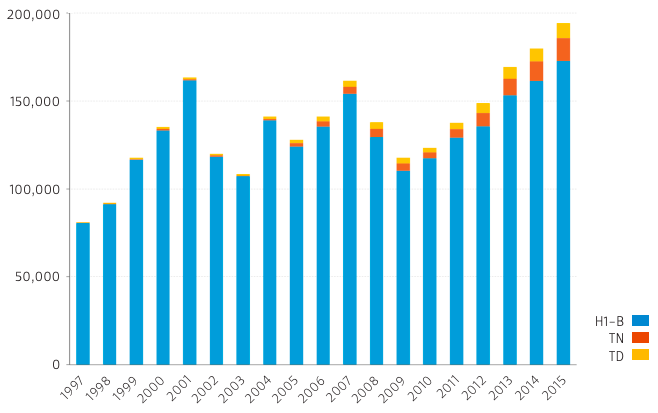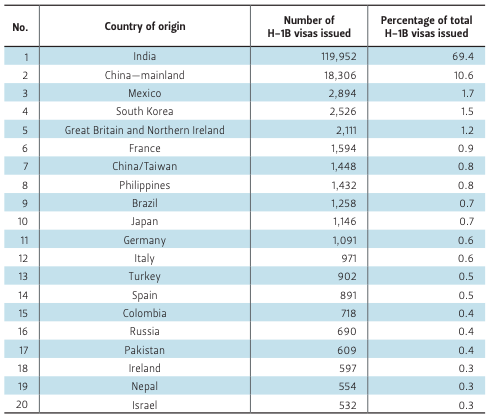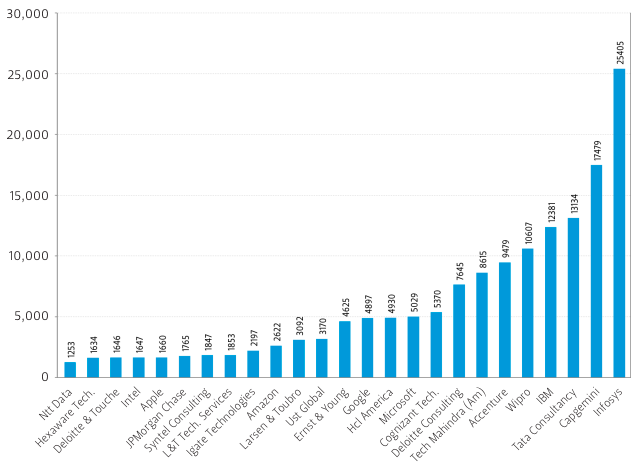U.S. Visas for Foreign Professionals: Insights on H-1B and TN Visas

Table of Contents
Author(s)
Camelia Tigau
Visiting Scholar, Mexico Center | Researcher, Center for Research on North America, Universidad Nacional Autónoma de MexicoShare this Publication
- Download PDF
- Print This Publication
- Cite This Publication Copy Citation
Tigau, Camelia. 2017. U.S. Visas for Foreign Professionals: Insights on H-1B and TN Visas. Issue brief no. 04.25.17. Rice University’s Baker Institute for Public Policy, Houston, Texas.
A discussion on the international mobility of highly skilled workers and their impact on the receiving country started soon after the end of World War II. Advances in transportation made it easier for professionals to work in different countries and actually increased their migration. In the 1950s, British media began taking a critical look at the “brain drain” of British professionals to the United States, setting up the framework of a longterm perspective that considers human capital as a value directly connected to national development.
A pioneering book co-authored by Walter Adams in 19681 and quoted hundreds of times in academic journals described how a brain drain harmed developing countries that exported their best and brightest, thus indirectly impeding the country’s economic development. That discussion was later complemented by its opposite view, that skilled diasporas could support the development of poor countries through money transfers and expanding networks of knowledge and philanthropy.
Although the two positions significantly differ in their views of migrants and the ethics of migration, they do, however, converge on the broad mobility of some professions over others—for example, it is easier for engineers and academics to migrate than medical doctors. More mobile professions also happen to be those that are more valued in a knowledge intensive economy. In particular, directly productive skills, such as those used by IT engineers, have been considered key to economic growth and social welfare; they are why the main immigrant-receiving countries—such as Canada, Australia and, until now, the U.S.—have placed them on a priority list of occupations required from abroad.
Recent political changes in the U.S., including President Trump’s stated intent to reconsider the H-1B visa to protect U.S. workers and possibly cancel TN visas if NAFTA is renegotiated, raise the question of the benefits of skilled migration. The purpose of this issue brief is to analyze the history and statistics related to these visas in order to discuss the impact of a possible cancellation of one or both of types.2
Specialty Worker Visas: A 65-Year-Old Story
The U.S. launched H-1 visas in 1952 under the Immigration and Nationality Act, with the purpose of importing certain specialty workers who were in short supply. While those visas did not refer to occupations in science and technology, as they do today, they are the predecessors of the current H-1B visas. The U.S. initially allowed 34,000 foreign workers to enter the country on H-1 visas; the number was increased to 58,000 in 1976, and even allowed universities to sponsor foreign workers as employees.3
The Immigration Reform and Control Act of 1990 created the current H-1B visa under President George H.W. Bush. Such visas are available to workers with at least a bachelor’s degree, are good for three to six years in the U.S., and provide for the possibility of a green card (resident status). What’s more, those who apply for a green card may also receive an H-1B visa extension for a seventh year while awaiting a response on residency status.
A great political and economic discussion since the 1990s considers whether H-1B visas encourage employers, especially IT companies, to hire foreign workers at a lower wage, thereby harming American workers. Proponents of H-1B claim that the visas actually help IT companies prosper and expand, and thereby provide more jobs for American workers.
The initial cap of 65,000 H-1B visas was reached in 1997; the Senate nearly doubled the quota in 1999, and then tripled it in 2003 (Figure 1). The same year, separate H-1B1 visas were set aside for citizens of Singapore and Chile under U.S.-Singapore and U.S.- Chile free trade agreements. The overall H-1B cap then reverted to 65,000, but since 2004, an additional 20,000 H-1B visas have been allocated for foreign workers with a master’s degree from a U.S. university who have received employment offers upon graduation.
Figure 1 — Historical Growth of H1, TN, and TD Visas

It is important to note that this cap applies to individuals new to this country or who are changing from a different visa category. It does not include those previously living in the U.S. on an H-1B visa who may seek to renew the same visa. This is why the annual statistics may be much higher than the 85,000 cap. Since 2004, the U.S. has allowed an average of 138,481 H-1B visas per year, with a peak of 172,748 in 2015, according to the U.S. State Department.
In 2015, citizens of India by far received the most H-1B visas, with 69.4 percent of all the H-1B visas granted. India was followed by mainland China, with 10 percent, and Mexico, with 1.7 percent (Table 1). The huge difference between the number of nationals from India who received an H-1B visa and all the others suggests that India may be the most affected by a change in the H-1B system.
Table 1 — H-1B Visas Issued, by Country (1–20, 2015)

The leading sponsors of H-1B visas in 2015 were Infosys, Capgemini, and Tata Consulting (Figure 2). Infosys has been the number one sponsor of H-1B visas since 2013. In the last 10 years, other major sponsors of H-1B visas have been IBM, Accenture, HCL, and Wipro, among others. Of the primary sponsors, Apple pays the highest average annual salary ($141,294), followed by Google, Microsoft, Deloitte Consulting, and Amazon (over $129,000 per year).
Figure 2 — Primary Corporate Sponsors of H-1B Visas (2015)

On April 18, 2017, President Trump signed an executive order that launched a 220- day review of H-1B visas. Real reforms are expected in December 2017 that will replace the present lottery system for H-1B visas with a selection process that only considers foreign workers with masters and doctorate degrees. However, as of yet, Trump has not cancelled H-1B visas, as he had proposed during the presidential campaign.
The NAFTA Labor Market
Although NAFTA was not designed to create a common labor market, the TN visa—available only to Mexican and Canadian professionals—was introduced in 1988 with a cap of 5,500 new visas per year for Mexican professionals and no cap for Canadian professionals. TN visas have the advantage of requiring less paperwork from the immigrant, but they also must be renewed yearly, and their spouses and children (admitted to the U.S. on a TD visa) cannot obtain a work permit. And, unlike the H-1B visa, the TN visa does not allow the holder to apply for a green card.
It is difficult to estimate the number of Mexicans and Canadians who actually benefit from TN and H-1B visas. As Costa and Rosenbaum show,4 “the U.S. government does not have an adequate and reliable estimate for the total number of temporary foreign workers who are authorized to be employed in the U.S. labor market in the main nonimmigrant visa classifications that authorize employment.” Therefore, as shown in Table 2, the counts provided by the U.S. Department of State and the U.S. Department of Homeland Security are quite different when it comes to the number of individuals arriving from Canada and Mexico on TN or H-1B visas.
Table 2 — H-1B & TN Visas Issued to Mexican and Canadian Citizens (2015)

A quick breakdown of visas issued to Mexicans migrating to the U.S. (Figure 3) shows that 83.5 percent went to visitors and business people (1,234,885 individuals in 2015), 6.9 percent to temporary agricultural workers (102,174 individuals in 2015), and 3.5 percent to temporary non-agricultural workers (51,301 individuals in 2015), according to the U.S. Department of State. H-1B and TN visas represented only 0.2 percent and 0.9 percent, respectively, of the total number of visas granted to Mexicans in 2015. In terms of the flow of Mexicans to the U.S., losing those visas would cut only 1.1 percent of total legal migration from Mexico.
Figure 3 — U.S. Visas For Mexicans (2015)

However, restricting these two visa categories would significantly cut the flow of Mexican professionals, who may instead decide to stay in Mexico or work in a different country. According to a 2017 report by Banco Bilbao Vizcaya Argentaria (BBVA), 97.66 percent of Mexican immigrants (legal and illegal) currently head to the U.S.5 Other countries that receive significant numbers of Mexican immigrants include Canada (0.76 percent), Spain (0.38 percent), and Germany (0.15 percent).
Discussion
It is clear that a decision to restrict or abolish H-1B visas—or worse, TN visas—would significantly reduce the number of skilled Mexican immigrants working in the U.S. It would also probably push individuals to adopt an alternate strategy in order to stay in the U.S., such as marriage or studying and working on a tourist visa.
There is also talk of multinational companies moving their facilities from the U.S. to other important countries that receive skilled migrants, such as Canada and Australia. If the H-1B visa program were to be canceled, some professionals from Mexico may consider returning to their home country—thus fulfilling the dream of neoclassical economists who support the repatriation, return, and retainment of skilled professionals who have been educated using the public resources of the professionals’ undeveloped or developing home countries.
The Trump administration’s proposal to restrict—rather than expand—the number of H-1B and TN visas is a political decision that has definitely challenged the theoretical premises of the knowledge economy. Under Trump, foreign professionals would apparently be considered unnecessary for economic growth; they could even be seen as an obstruction to social development. As a result, foreign workers in the U.S. could be expelled from the country that currently admits the highest number of legal immigrants in the world.
Does the U.S. have enough skilled nationals to replace the foreign professionals who might leave if H-1B visas are cancelled? The path to an answer may first require the choice to protect U.S. nationals over foreigners. There is no doubt that such a choice would lead to a major restructuring of U.S. business practices and important changes to the definition of a knowledge economy.
Endnotes
1. Walter Adams, ed., The Brain Drain (McMillan Company: NY and Collier McMillan Ltd: London, 1968).
2. Research based on data from State Department–Bureau of Consular Affairs, as of February 7, 2017, http://bit.ly/2l1XQCm.
3. Rob Sanchez, “A Legislative History of H-1B and Other Immigrant Work Visas,” 2015, http://bit.ly/2op4Egc.
4. Daniel Costa and Jennifer Rosenbaum, “Temporary foreign workers by the numbers,” Economic Policy Institute, March 7, 2017.
5. Juan José Li Ng, et al., Yearbook of migration and remittances, Mexico: BBVA Bancomer, 2016.
This material may be quoted or reproduced without prior permission, provided appropriate credit is given to the author and Rice University’s Baker Institute for Public Policy. The views expressed herein are those of the individual author(s), and do not necessarily represent the views of Rice University’s Baker Institute for Public Policy.


